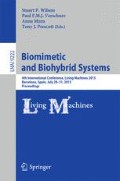Abstract
In this paper, we present our work on the training of robotised architectural components of intelligent buildings, focusing on how architectural components can learn to behave animalistically, according to the judgment of human users. Our work aims at recovering the lost contact with animals in the urban context, taking advantage of biophilic empathy. The parameters governing the robotised elements we propose are mainly qualitative (emotions and aesthetical perception), which cannot easily be described by mathematical parameters. Additionally, due to their complexity, it is often impossible –or at least impractical, to hardcode suitable controllers for such structures. Thus, we propose the use of Artificial Intelligence learning techniques, concretely Evolutionary Algorithms, to allow the user to teach the robotised components how to behave in response to their resemblance to specific animal behaviors. This idea is tested on an intelligent façade that learns optimal configurations according to the perception of aggressiveness and calmness.
Access this chapter
Tax calculation will be finalised at checkout
Purchases are for personal use only
Preview
Unable to display preview. Download preview PDF.
References
Benyus, J.: Biomimicry - Innovation Inspired by Nature. Harper Collins Publishers, New York (1997)
Faber Taylor, A., et al.: Views of nature and self discipline: evidence from inner city children. Journal of Environmental Psychology 22, 49–63 (2002)
Gauci, J., Stanley, K.O.: Autonomous evolution of topographic regularities in artificial neural networks. Neural Computation 22(7), 1860–1898 (2010)
Igel, C., Suttorp, T., Hansen, N.: A computational efficient co-variance matrix update and a (1+1)-cma for evolution strategies. In: Proceedings of the 8th Annual Conference on Genetic and Evolutionary Computation, GECCO 2006, New York, NY, USA, pp. 453–460. ACM (2006)
Lohr, V., et al.: Interior plants may improve worker productivity and reduce stress in a windowless environment. Journal of Environmental Horticulture 14 (1996)
Manrique, C.: Escrito en el Fuego. Edirca Editorial, Las Palmas de Gran Canaria (1988)
Mazzoleni, I.: Architecture Follows Nature-Biomimetic Principles for Innovative Design. CRC Press, Boca Raton (2013)
Mormann, F.: Captivated by critters: Humans are wired to respond to animals. ScienceDaily, September 9, 2011. California Institute of Technology (cited June 1, 2014). www.sciencedaily.com/releases/2011/09/110909091219.htm
Nagel, T.: What Is It Like to Be a Bat? The Philosophical Review 83(4), 435–450 (1974)
Pawlyn, M.: Biomimicry in architecture. RIBA Publishing, London (2011)
Pedersen Zari, M.T.G.: Biomimetic approaches to architectural design for increased sustainability. In: The SB 2007 NZ Sustainable Building Conference, Auckland (2007)
Reed, B.: Shifting our mental model – sustainability to regeneration. In: Rethinking Sustainable Construction 2006: Next Generation Green Buildings, Sarasota, Florida (2006)
Rossi, C., Gil, P., Coral, W.: Evolutionary training of robotised architectural elements. In: Mora, A.M., Squillero, G. (eds.) EvoApplications 2015. LNCS, vol. 9028, pp. 819–830. Springer, Heidelberg (2015)
Stanley, K.O., Bryant, B.D., Miikkulainen, R.: Real-time neuroevolution in the nero video game. IEEE Trans. on Evolutionary Computation 6(9), 653–668 (2005)
Storey, J.B., Zari, M.P.: Factor X - well being as a key component of next generation green buildings. In: Proc. of the Rethinking Sustainable Construction 2006 Conference, Sarasota, Florida, USA (2006)
Ulrich, R.: View through a window may influence recovery from surgery. Science 224(4647) (1984)
Wilson, E.O.: Biophilia. The Human Bond with Other Species. Harvard University Press, Cambridge (1984)
Wright, F.L.L.: The natural house. Bramhall House, New York (1954)
Author information
Authors and Affiliations
Corresponding author
Editor information
Editors and Affiliations
Rights and permissions
Copyright information
© 2015 Springer International Publishing Switzerland
About this paper
Cite this paper
Gil, P., Rossi, C., Coral, W. (2015). Biophilic Evolutionary Buildings that Restore the Experience of Animality in the City. In: Wilson, S., Verschure, P., Mura, A., Prescott, T. (eds) Biomimetic and Biohybrid Systems. Living Machines 2015. Lecture Notes in Computer Science(), vol 9222. Springer, Cham. https://doi.org/10.1007/978-3-319-22979-9_47
Download citation
DOI: https://doi.org/10.1007/978-3-319-22979-9_47
Published:
Publisher Name: Springer, Cham
Print ISBN: 978-3-319-22978-2
Online ISBN: 978-3-319-22979-9
eBook Packages: Computer ScienceComputer Science (R0)

